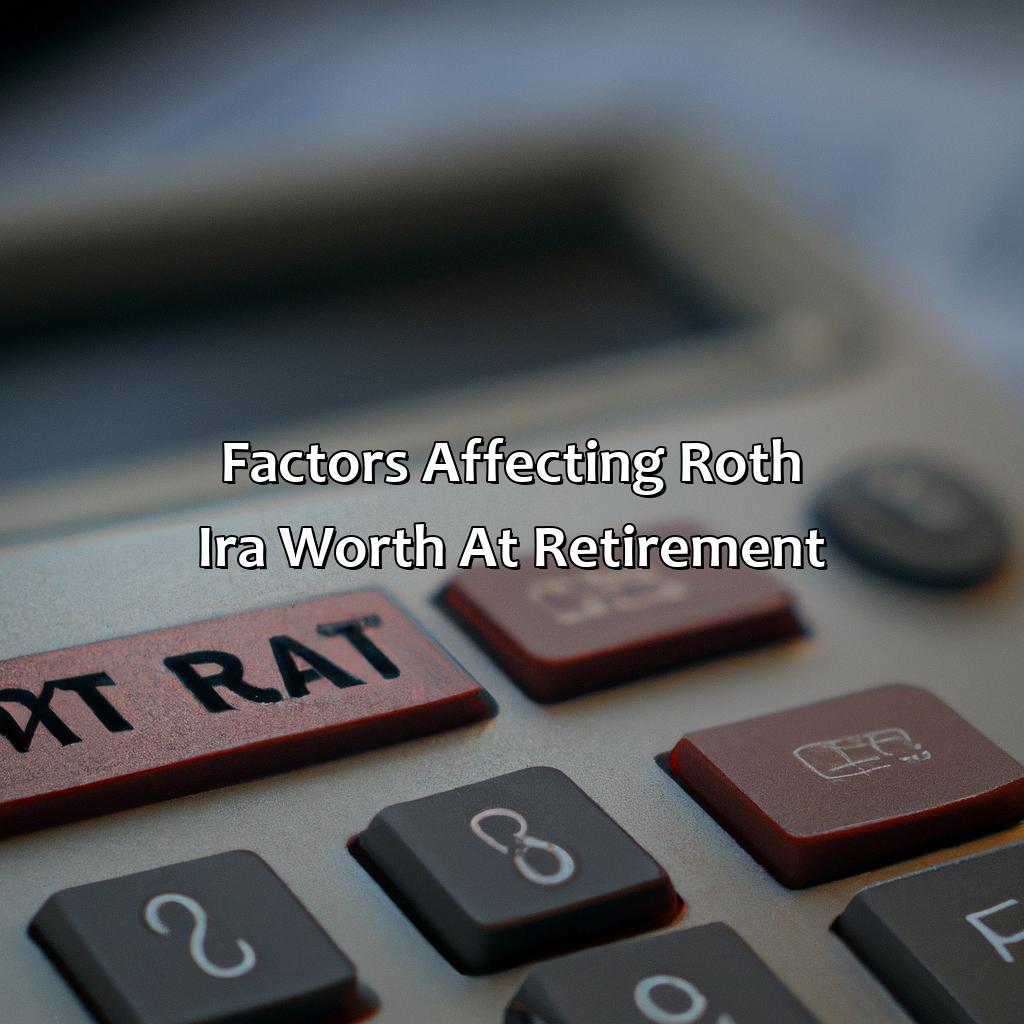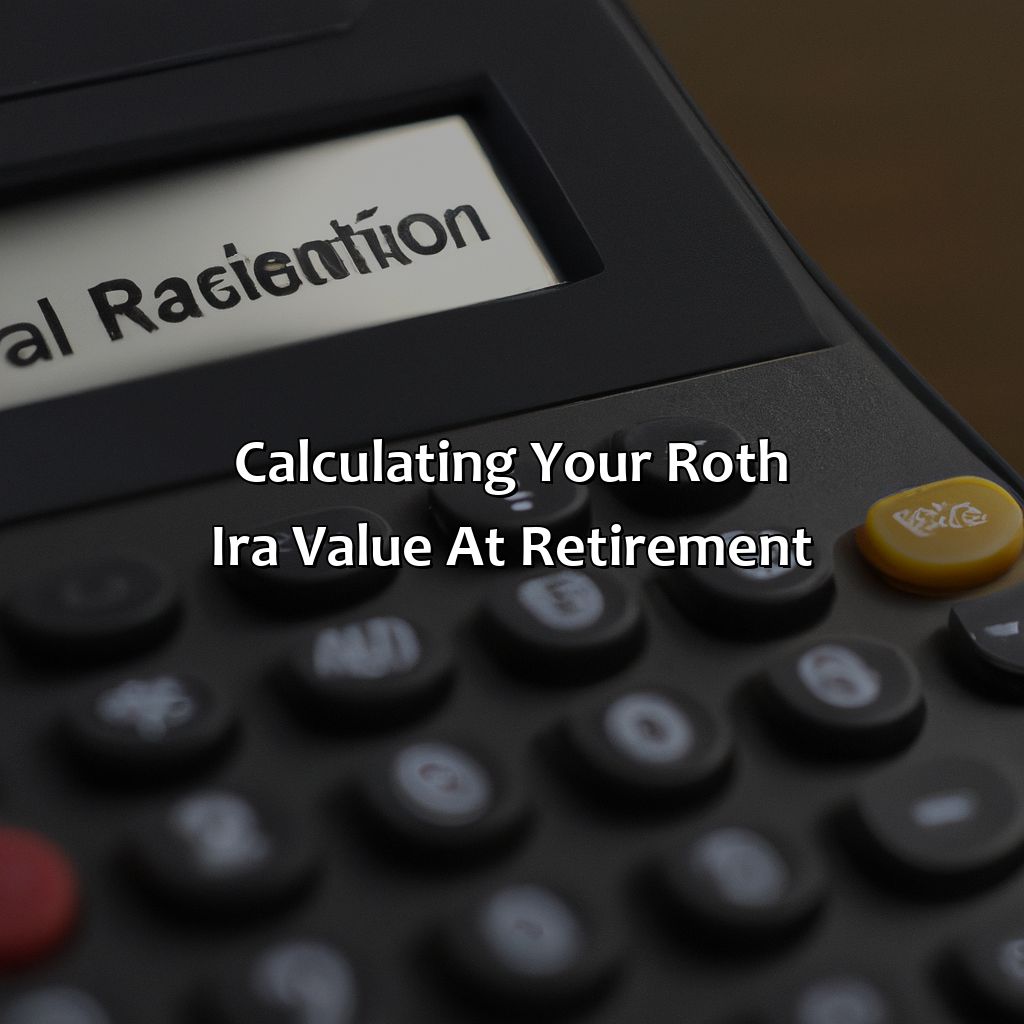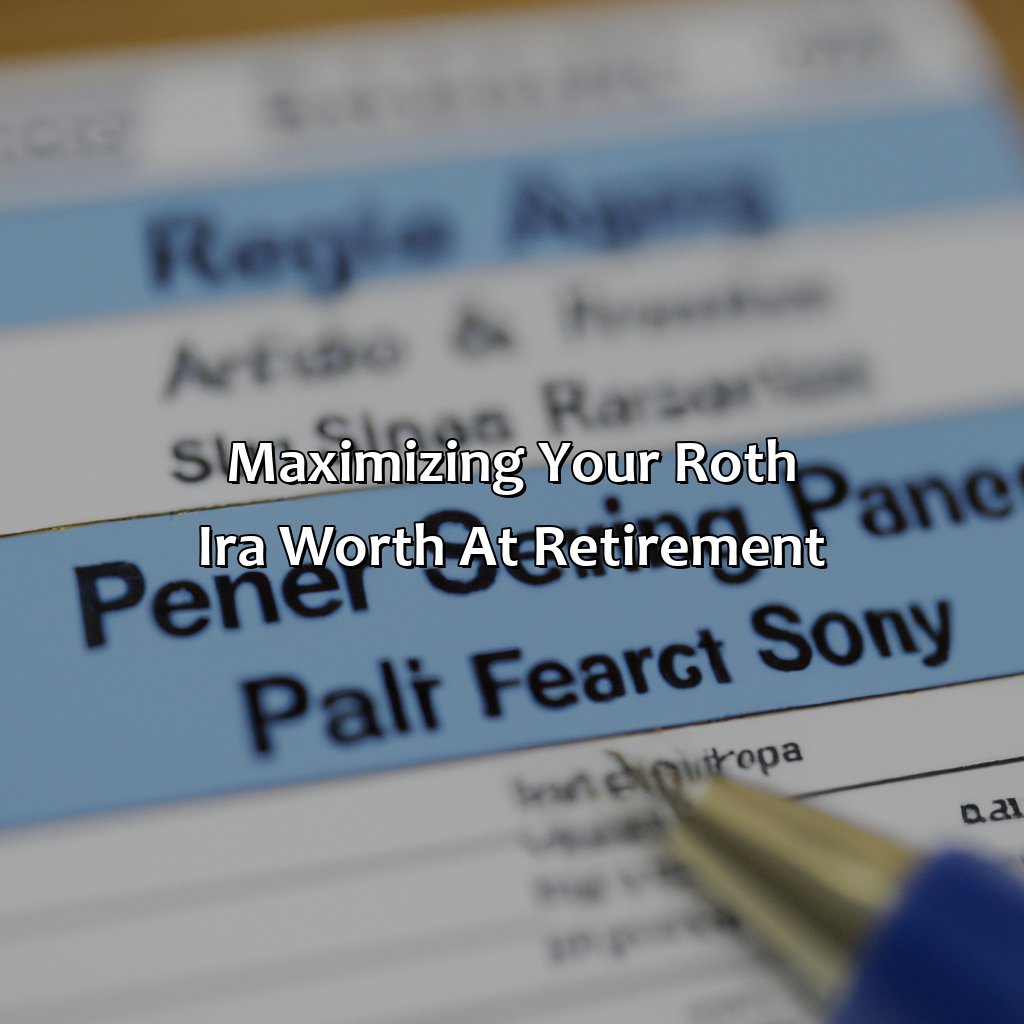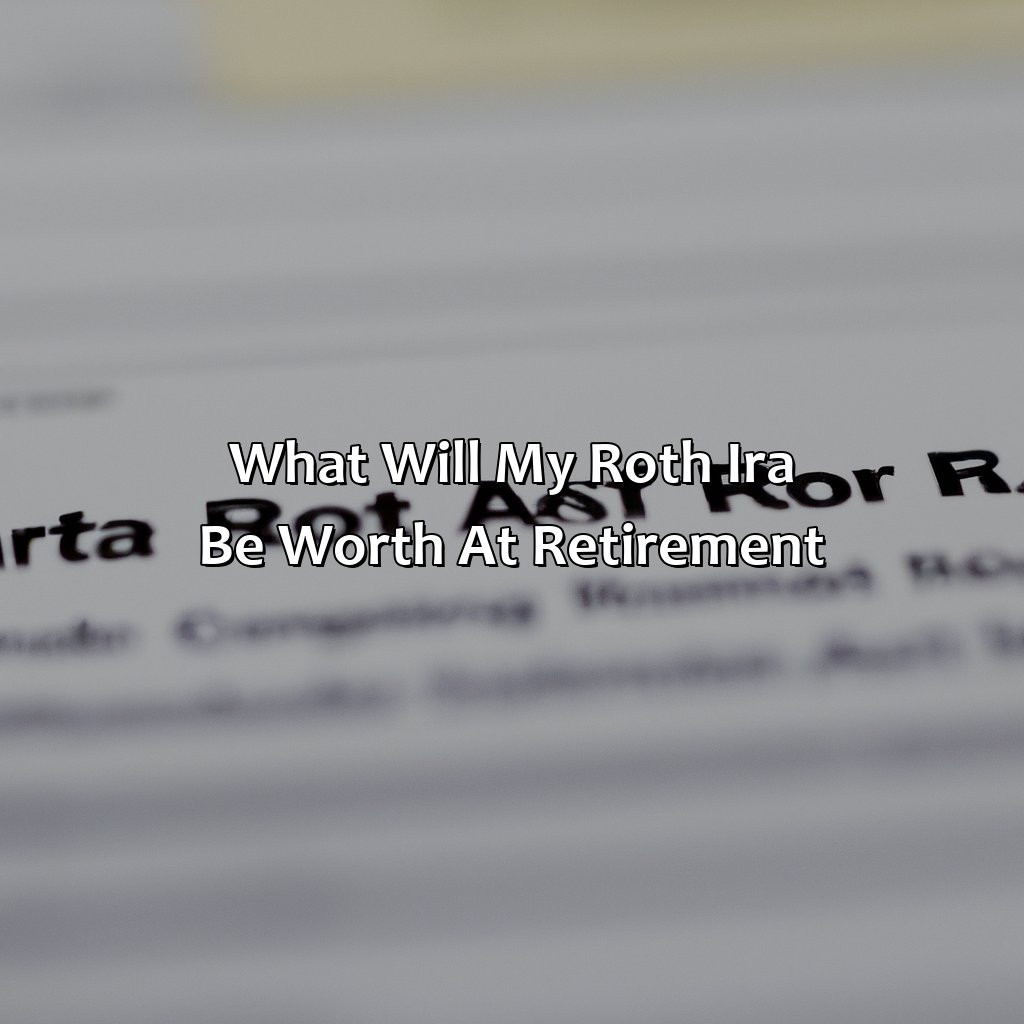What Will My Roth Ira Be Worth At Retirement?
Key takeaway:
- Contributions are a major factor in determining the worth of your Roth IRA at retirement. Making regular contributions, even small ones, can greatly increase your retirement savings over time.
- Investment returns also play a significant role in the value of your Roth IRA. Choosing a diversified portfolio and being mindful of fees can help you maximize returns and achieve your retirement goals.
- Withdrawals can impact your Roth IRA worth at retirement. By avoiding early withdrawals and being strategic about your withdrawal strategy, you can ensure that your Roth IRA lasts as long as you need it to in retirement.
You want to know the future value of your Roth IRA savings at retirement? Investing in a Roth IRA can be a smart way to prepare for retirement but calculating your retirement savings can be tricky. In this article, we’ll show you how to determine the value of your Roth IRA when you retire.
Factors Affecting Roth IRA Worth at Retirement
Let’s delve into the three factors that make up the worth of your Roth IRA come retirement. These are contributions, investment returns, and withdrawals. We’ll look at each one separately to find out how they can influence your Roth IRA. Contribution amount, return on investments, and withdrawals all play a role. Knowing these details can help you better plan for your retirement.

Image credits: retiregenz.com by Joel Washington
Contributions
To maximize Roth IRA growth, one must fully understand the nuances of contributions. IRA holders can make contributions every year up to certain limits.
Annual Contribution Limits: The Internal Revenue Service (IRS) sets limits for how much an individual can contribute per year. For 2021 and 2022, the limit is $6,000 if you’re under 50, and $7,000 if you’re over 50.
Eligibility Based on Income: Roth IRAs have income eligibility requirements that may restrict contributions or require a different contribution method. It’s important to note these when planning your investment strategy.
Conversions: Traditional IRAs can be converted to Roth IRAs, but it’s crucial to understand the tax implications associated with it.
It’s not just about contributing – investing in assets that align with retirement goals and risk tolerance will affect overall outcomes as well. Diversified investments across stocks and bonds provide long-term growth potential.
Pro Tip: Stay aware of annual limits, eligibility criteria and tax laws – they are subject to change frequently.
Remember, the only thing guaranteed in investment returns is that your broker will always get their cut.
Investment Returns
Intricate compound interest options deliver impressive gains to the investors who invest in a Roth IRA account. These investment returns are subject to fluctuations with changing market conditions, but they remain exceptionally profitable if monitored regularly.
The Roth IRA plan allows pass-through tax treatments on qualified withdrawals and contributions, so long as specific conditions of taxation requirements and maturity period constraints have been met. As an investor, it’s essential to keep track of the returns during the time horizon of your investment strategy.
Diversification of portfolio by allocating funds in bonds, shares, ETFs, or mutual funds provide flexibility to choose investments that fit financial goals while reducing uncertainty risks due to volatility. A balanced investment mix is crucial for mitigating market perils and getting predictable revenues in your retirement years.
Take heed of the benefits demonstrated by compounding interest when starting early in your Roth IRA investment journey. By committing capital into a diversified portfolio with appropriate risk management techniques, you can reap lucrative rewards that focus on long-term wealth creation rather than only short term profits.
Make sure you optimize instead of overstretching your financial limits towards wiser investments over time. By doing so, you’ll motivate yourself to accomplish future ambitions with an optimistic outlook while preparing holistically for retirement.
Withdrawals from your Roth IRA may be tax-free, but be careful not to spend it all in one place…like a time-share in Florida.
Withdrawals
Payouts from the Roth IRA
Roth IRA is a retirement investment vehicle with several withdrawal strategies. While making withdrawals, keep in mind that the tax laws and regulations govern all Roth IRA payouts.
A 3-Step Guide to Withdrawals:
- Check your age: The fiscal policy defines two groups of people; above or below 59½ years. If you are less than 59½ years old, the state may levy an additional penalty for early disbursement (10% tax obligation). On the other hand, if you are over 59½ years old, there is no such penalty.
- Determine the 5-year-rule: This rule underlines opening any brand-new Roth account is essential to elapse five years from their creation date to avoid any taxes or penalties on your disbursement. Also, to be eligible for qualifying distributions.
- Recordkeeping: Keep track of withdrawing charges that can be annulled against earnings boost the worth of all remaining investments in your portfolio. Recording will aid administrators to keep count of accounts for tax obligations.
In addition, it’s essential to take into account life changes while computing disbursements with Roth IRAs. Experts suggest taking out contributions before gains if one needs money before reaching retirement age. If sustained as long as possible and used after discretion, an untaxed withdrawal provides substantial results once retirement funds mature later on.
Overall, withdrawals from Roth IRAs must be approached cautiously and strategically by keeping regulations listed under Internal Revenue Code section 72(t), which involves specified dollar amounts payable by tax laws never to forget subtler aspects that may have special circumstances concerning withdrawals.
Ready to do some math? Just remember, the only thing certain in life are death, taxes, and the fact that your Roth IRA value at retirement will never be exactly what you expected.
Calculating Your Roth IRA Value at Retirement
Calc your Roth IRA value for retirement? Use a Roth IRA Calculator or do manual calculations! Here’s an overview of the sub-sections:
- Roth IRA Calculator
- Manual Calculations
Which one works best for you?

Image credits: retiregenz.com by David Washington
Using a Roth IRA Calculator
Calculating Your Roth IRA Value at Retirement-The Perfect Tool
A Roth IRA Calculator is useful to determine your retirement savings. Here’s how:
- Open the calculator from a reliable website.
- Enter your contributions per year, along with your investment time frame and earnings rate.
- Add other details such as age, income, and expected expenses in retirement.
- The calculator will analyze and show you the estimated results of your savings in terms of final account balance, annual income generated by your account during retirement years, and more.
- You can modify inputs to visualize different outcomes for various scenarios such as starting contributions earlier or later, increasing the contribution amount yearly and so on.
The efficiency of using a Roth IRA Calculator lies in its ability to present complex numerical data in a simple manner.
Want to learn more about Roth IRAs? Check out this source: “Roth Vs. Traditional IRA: Which Is Best for You?” by Andrea Coombes on NerdWallet.com.
Get ready to whip out your calculator and exercise those brain cells – it’s time for some manual calculations!
Manual Calculations
For those who wish to manually calculate their Roth IRA value at retirement, there are a few steps you can follow:
- Determine your current age and expected retirement age.
- Calculate the number of years until retirement.
- Estimate an average annual rate of return for your Roth IRA investments.
- Calculate your total contributions to the Roth IRA over the years.
- Estimate the future contributions and tax-free earnings on the account, using the same estimated rate of return as step 3.
- Add up all contributions and earnings from steps 4 and 5 to obtain an estimation of your Roth IRA value at retirement.
Additionally, keep in mind that these manual calculations do not take into account any unforeseen circumstances that may affect your investments or income in the future.
It is suggested that individuals also seek advice from a financial advisor before making any big decisions regarding their Roth IRA investments. A financial advisor can help with planning based on individual circumstances and investment goals, ensuring a more accurate calculation of their Roth IRA’s worth at retirement.
Make your Roth IRA worth more than your ex’s alimony payments with these tips.
Maximizing Your Roth IRA Worth at Retirement
Maximize Roth IRA worth when you retire! Increase contributions, diversify investments, and minimize withdrawals. These three steps will help ensure a prosperous retirement.

Image credits: retiregenz.com by Harry Duncun
Increasing Contributions
Investing More for Your Roth IRA’s Growth
Boosting your investments in a Roth IRA is crucial towards maximizing your balance at retirement. Here’s how to make it work:
- Set-up automatic deductions in your payroll, amounting to at least 10% of your salary.
- Allocate windfalls from bonuses or tax returns into your Roth IRA account.
- Diversify your account holdings by embracing a mix of stocks and bonds.
- Tune down the risks of these assets to fit in with your investment risk tolerance.
- Become more volunteeristic and add a portion of wages made overtime to your Roth IRA account.
- Stay on top with regular reviewing the contributions limit set up by the IRS each year and max out as much as possible given your current income level.
One unique fact: having multiple IRAs doesn’t lift contribution limits. However, doubling-up IRAs have some benefits since it hits different targets, like taxes and asset protection.
A well-known financial strategist increased his Roth IRA contribution limits through effective budget manipulation and an unselfish mindset. Despite an average annual income, remaining committed and flexible toward his financial goals eventually paid off – enabling him to retire peacefully without economic burden.
Putting all your eggs in one basket is a risky investment strategy, but it’s a great way to make an omelette…or lose your retirement savings.
Diversifying Investments
Investment Diversification for Optimal Roth IRA Growth
Diversifying your investments is crucial to maximize the worth of your Roth IRA at retirement. By spreading your investments across different asset classes, such as stocks, bonds, and real estate funds, you reduce the risk of losses from any single asset. This approach offers a more balanced and diversified portfolio with higher potential returns.
Investing in a wide range of assets brings several benefits. For example, stocks offer high potential returns but come with greater risk. Bonds provide a lower-risk option that generates steady income but may not create wealth over time. Real estate investment trusts (REITs) hold commercial properties and generate robust dividends while diversifying away from mainstream types of assets like stocks and bonds.
By diversifying your Roth IRA investments in these ways or others, you can both reduce risk and increase potential returns in retirement. Doing this means assessing your risk profile early and identifying an investment strategy that aligns with it.
In summary, remember that optimizing the worth of your Roth IRA at retirement through investment diversification is critical to achieving financial goals in later life. Don’t miss out on the benefits of this strategy by limiting yourself to one type of asset class. Always assess your risk tolerance and invest accordingly for maximum long-term growth potential.
Don’t withdraw from your Roth IRA unless you’re ready to face the wrath of Aunt Sally and her bingo night crew.
Minimizing Withdrawals
To Optimize Roth IRA Payouts:
- Protect: You can protect yourself by ensuring enough money goes into your Roth IRA. Distributing your earnings with people you trust is advisable if you own a business.
- Strategize 1: Withdrawing minimum amounts at age 72, since that age requires a mandatory distribution, reducing taxes, and increasing income.
- Strategize 2: Convert traditional IRAs to Roth during lower-income years. Remember that the conversion adds taxable income in the year they occur.
- Make Use of Social Security: Utilize Social Security benefits to reduce withdrawals from your Roth IRA.
It is worthwhile to consider getting a competent financial advisor. It can help maximize your portfolio’s value, significantly assist with estate planning concerns, and develop strategies based on current market data.
Similar success stories abound among retiring individuals who employ such practices. For instance, a retiree saved for two decades using his Roth IRA until he had saved enough to purchase his vacation home outright while still supporting his family with regular withdrawals from his account.
Five Facts About “What Will My Roth IRA Be Worth at Retirement?”:
A Roth IRA is a retirement savings account that allows your money to grow tax-free. (Source: Investopedia)
The amount your Roth IRA will be worth at retirement depends on factors such as your contributions, investment returns, and time horizon. (Source: NerdWallet)
The earlier you start investing in a Roth IRA, the more time your money has to grow. (Source: CNBC)
In 2021, the maximum contribution limit for a Roth IRA is $6,000 for those under 50 and $7,000 for those 50 and older. (Source: IRS)
A Roth IRA offers flexibility in retirement, allowing you to withdraw contributions at any time without penalty and required minimum distributions do not apply. (Source: Fidelity)
FAQs about What Will My Roth Ira Be Worth At Retirement?
What factors affect what my Roth IRA will be worth at retirement?
The value of your Roth IRA at retirement will depend on several factors, including the amount you contribute each year, the rates of return on your investments, and the duration of the account’s growth.
Is it possible to estimate the value of my Roth IRA at retirement?
While it is impossible to predict the exact value of your Roth IRA at retirement, you can use online calculators and industry projections to estimate your potential savings based on your current contribution rate and age.
What strategies can I use to increase the value of my Roth IRA at retirement?
You can maximize the value of your Roth IRA by contributing as much as possible each year, diversifying your investments, and taking calculated risks with high-yield securities. Additionally, you can consider working with a financial advisor to optimize your investment strategy.
Will taxes affect the value of my Roth IRA at retirement?
No, you will not be taxed on the value of your Roth IRA at retirement because you will have already paid taxes on your contributions. This makes Roth IRAs an excellent option for individuals who want to save money on taxes in the long term.
What other retirement savings options should I consider in addition to my Roth IRA?
It is wise to diversify your retirement savings by considering other options such as a 401(k), pension plan, or traditional IRA. These alternative accounts offer different tax benefits and investment options that can strengthen your overall retirement plan.
How often should I review the value of my Roth IRA and make adjustments?
You should review the value of your Roth IRA at least once a year and make adjustments based on your current financial situation and retirement goals. It is also advisable to seek the advice of a financial advisor to ensure that your investment strategy is optimized for your unique needs.
 Checkout this IRS Loophole
Checkout this IRS Loophole 



